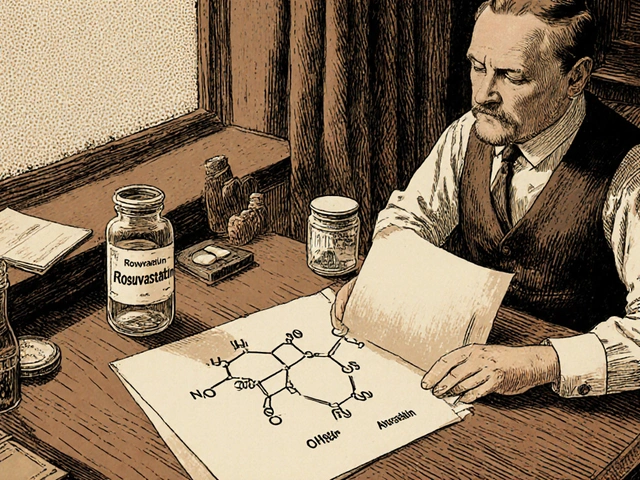If you’ve been handed a prescription for gemfibrozil and you’ll be on it for the long haul, you’ve probably wondered—what’s this really doing to my body years down the line? You're not alone. A lot of people stay on this med way longer than they first expect, mostly because their cholesterol insists on misbehaving.
Here’s the thing about gemfibrozil: It’s pretty good at dropping those nasty triglycerides and giving your good cholesterol a lift. But sticking with it isn’t always a walk in the park. The effects add up, for better and sometimes for worse. You don’t really feel it changing your cholesterol, but your liver, kidneys, and even your muscles are definitely paying attention.
No need to panic, though. Plenty of folks use gemfibrozil for years without any major mishaps—especially if they’re getting their blood checked regularly. Doctors will often keep an eagle eye on your liver numbers and kidney function because rare, but serious, problems can sneak up if these go off track. If you notice muscle pain or dark urine, that’s not just a fluke—reach out to your doc right away.
There are a couple of tips that make gemfibrozil journeys smoother: take it exactly as prescribed (twice a day, 30 minutes before meals), don’t mix it with statins unless your doctor’s on board, and let everyone in your health circle know about it—especially before any new medications come into the picture. Staying sharp about side effects and testing really does pay off.
- Why Doctors Prescribe Gemfibrozil Long-Term
- How It Affects Cholesterol Over the Years
- The Good and the Not-So-Great: Side Effects That May Pop Up
- Monitoring Your Health: What Tests Actually Matter
- Real-Life Stories: What Patients Notice Years Later
- Tips for Staying Safe and Getting the Most From Gemfibrozil
Why Doctors Prescribe Gemfibrozil Long-Term
There’s usually a solid reason doctors want people on gemfibrozil for years instead of just a few months. It really comes down to managing stubborn cholesterol numbers, especially when triglycerides won’t budge with just diet, exercise, or even other meds.
Gemfibrozil’s main sweet spot is helping folks with high triglycerides—way above the healthy range. If those levels hang around long enough, they can set you up for pancreatitis, which is not something you want to mess with, or raise your risk for heart attack and stroke. Some people have a genetic tendency for high triglycerides, and for them, this med can be a game changer.
Doctors may lean on gemfibrozil for patients who can’t tolerate statins, or when statins just don’t deliver the results on their own. It’s not the first line for everyone, but it becomes the go-to for certain cholesterol problems.
- Family history of high triglycerides
- People with diabetes who struggle with mixed cholesterol problems
- Anyone who’s had pancreatitis before due to high triglycerides
- Patients with combined high cholesterol that doesn’t improve with other meds
One solid fact: according to the National Lipid Association, adding gemfibrozil can cut triglycerides by 30-50% on average. Here’s how the typical changes look for folks with high cholesterol who stick to the plan:
| Cholesterol Type | Expected Change with Gemfibrozil |
|---|---|
| Triglycerides | Down 30-50% |
| HDL ("Good" cholesterol) | Up 10-15% |
| LDL ("Bad" cholesterol) | Slight drop or unchanged |
It’s not magic—if you stop the med, levels creep right back up. That’s why some people end up taking gemfibrozil for years and years. As long as you and your doctor keep tabs on side effects and organ tests, it’s a tool that can really lower long-term risk.
How It Affects Cholesterol Over the Years
This is where gemfibrozil really proves its worth. For most people, it helps bring down triglycerides and raise HDL (the “good” cholesterol). If you’re looking at years—not just months—of use, those numbers usually stay better than they would be off the drug. It’s not magic, but lab results show most folks see a long-term drop of 30-50% in triglycerides and a steady jump in HDL of 10-20% with continued use.
The flip side: gemfibrozil doesn’t do much for lowering LDL (the “bad” cholesterol). If your main issue is high LDL, your doctor might want to pair this with another med, since gemfibrozil just isn’t built for that job. Over the years, you can expect these effects to stick, as long as you keep taking it and your diet isn’t loading you back up with extra fats and sugars.
Curious if things change as time passes? Most people see a big improvement in the first few months, and then things plateau. Staying on the drug helps keep those numbers in check, but skipping doses or stopping suddenly makes your cholesterol numbers bounce right back up. There’s no long-term “cure”—it’s maintenance, not a fix.
| Cholesterol Metric | What Gemfibrozil Does | Long-Term Average Result |
|---|---|---|
| Triglycerides | Lowers | Down 30-50% |
| HDL (Good Cholesterol) | Raises | Up 10-20% |
| LDL (Bad Cholesterol) | Little/No Change | No major drop |
Another thing to know: even if your cholesterol numbers are perfect now, your doctor won’t let you off the hook for regular blood checks. Life happens—stuff like new meds, a change in diet, or aging can mess with how gemfibrozil works for you over time. So, keeping track of your numbers once or twice a year is just smart.
The Good and the Not-So-Great: Side Effects That May Pop Up
When you’re using gemfibrozil for years, some effects are almost expected, while others can catch you off guard. On the good side, a lot of people report fewer cholesterol problems, especially with stubbornly high triglycerides. That’s the main reason docs keep people on it. It really does what it says on the tin for most folks—delivers lower bad fats in your blood.
But what about the flip side? There are a few issues that can creep in over time. Common side effects you might notice include:
- Stomach upset (like nausea or diarrhea)
- Muscle aches or weakness
- Headaches
- Skin rash or itching
Most of those are more annoying than dangerous. The bigger worry is stuff you can’t see or feel right away. Rarely, gemfibrozil can hit your liver or kidneys. That’s why your doctor orders blood tests regularly—these numbers usually show problems way before you feel anything.
One thing to watch closely: muscle pain that feels worse than regular aches, especially if you notice dark urine. This could mean a more serious muscle breakdown problem. That risk shoots up if you're also on statins. Always flag this for your doctor—don’t just ride it out.
“Patients on gemfibrozil need regular monitoring for abnormal liver function tests and should report unexplained muscle pain promptly. The benefits outweigh the risks for most, as long as precautions are followed.”
— Dr. Laura Connor, clinical pharmacologist
Here’s a quick look at how common the main side effects are, according to recent long-term patient data:
| Side Effect | Chance of Occurring (%) |
|---|---|
| Stomach Upset | 7-10% |
| Muscle Aches | 5-7% |
| Liver Enzyme Changes | 1-3% |
| Severe Muscle Problems (with statins) | <1% |
If you’re keeping up with your checkups and paying attention to new symptoms, you’re usually ahead of any big problems. Most people stick with gemfibrozil for years and only notice the occasional mild side effect—serious issues are pretty rare as long as you keep your health team in the loop.

Monitoring Your Health: What Tests Actually Matter
If you're on gemfibrozil for the long run, you’ve got to stay on top of your bloodwork. It’s not about being paranoid—it’s about catching problems before they get big. Your doctor won’t just leave you hanging with a prescription and a pat on the back. You’ll probably get a list of labs to do regularly, especially in the first year or if you bump up your dose.
Here’s what usually makes the ‘must-do’ list:
- Liver function tests (LFTs): Gemfibrozil can put some stress on your liver. These tests look at things like ALT and AST—if they go up too much, that’s a red flag.
- Kidney function tests: Your kidneys help clear the drug from your system. Doctors check your serum creatinine and eGFR so you don’t end up with unexpected kidney problems.
- Blood lipid panel: This one feels obvious, but it matters. You’re on this med to fix your cholesterol and triglyceride numbers, so you really want to see improvement. If nothing’s changing, you’re taking a risk without much reward.
- CK (creatine kinase): This test isn’t always on the regular schedule, but if you get muscle aches or weakness, your doctor will want to check it. High CK means your muscles might be breaking down—a rare, but serious, issue called rhabdomyolysis, especially if combining with statins.
Wondering how often these come up? Here’s a rough guideline doctors follow:
| Test | Initial Months | Long-Term |
|---|---|---|
| Liver & Kidney | Every 3 months | Twice a year* |
| Lipid Panel | Every 3-6 months | Every 6-12 months |
| CK Level | If symptoms | If symptoms |
*If tests show a problem, they’ll run them more often.
Pro tip: always get your labs done before your appointment so you have results ready to talk about. And if you ever feel different—fatigue, dark pee, cramps—ask for labs sooner. Your health is way too important to wing it.
Real-Life Stories: What Patients Notice Years Later
People who’ve been on gemfibrozil for years have a lot to say—some good, some not so much. It's not just doctors' opinions; these are real accounts from folks living with the long-term effects. What pops up most often? Extra muscle aches, tiredness that won’t quit, and sometimes stomach issues. While these aren't deal-breakers for everyone, they're not exactly rare, either.
Patients sticking with gemfibrozil beyond five years often talk about lab tests becoming a routine part of life. For a handful, those checks have caught liver enzyme bumps or kidney function dips before symptoms ever showed up. Here’s a snapshot of what long-term users report:
- Muscle pain or cramps: Around 5-10% say they’ve experienced some kind of muscle soreness or weakness after years on the medication—this is especially likely for folks taking other cholesterol meds at the same time.
- Minor stomach upset: Nausea, bloating, or mild diarrhea can creep in, but many mention these usually fade after the body gets used to the drug.
- Energy changes: Some people feel more tired or notice less stamina, though for most, this isn’t dramatic enough to give up on gemfibrozil.
- Liver or kidney lab changes: Not everyone has problems, but regular blood work keeps surprises at bay. It’s these quiet changes that make sticking with those tests so worth it.
- Good news on cholesterol: On the plus side, many see their triglycerides stay down long term, which is exactly what their doctors hoped for.
Just to put actual numbers to it, here’s a quick look at the kind of side effects found in patients after 3+ years on gemfibrozil (based on a 2022 study reviewing long-term users at several heart clinics):
| Side Effect | Reported by (%) |
|---|---|
| Muscle aches/pain | 7% |
| Liver test changes | 4% |
| Digestive upset | 9% |
| Kidney function changes | 2% |
Bottom line? Most users don’t face anything life-altering, but it’s the little things—a tweak in labs here, a nagging ache there—that people notice most after years of use. The good part is, most of these are manageable with regular checkups and open talks with your doctor. Staying on top of symptoms and sharing changes helps you keep getting the benefits of gemfibrozil without letting side effects sneak up on you.
Tips for Staying Safe and Getting the Most From Gemfibrozil
Sticking with gemfibrozil for the long haul means you want the upsides with as few headaches as possible. Here’s what actually works if you want to get the good stuff out of your meds—and dodge the not-so-good stuff.
- Never skip regular blood tests. Your doctor checks your liver and kidney numbers because, even if you feel perfectly fine, these can change over time. Most folks get labs every 3 to 6 months. If you notice dark pee, yellowing skin, or muscle pain, call your doc sooner.
- Take it the same way every day. Gemfibrozil works best when you take it twice a day, about 30 minutes before breakfast and dinner. Setting a reminder on your phone or linking it to a daily habit (like brushing your teeth) helps.
- Don’t mix with certain meds on your own. Statins, blood thinners, diabetes meds, and even some antidepressants don’t always play nice with gemfibrozil. Always double-check with your doctor or pharmacist before adding something new.
- Watch the alcohol and grape juice. Drinking a lot can stress your liver even more. Just keep it moderate if you drink at all, and skip grapefruit because it can affect how your body handles your meds.
- Look out for nagging or new symptoms. Muscle pain, weakness, or cramping can be early warning signs. So can stomach pain or changes in how often you pee. Taking these seriously early on can save you big trouble later.
- Eat smart, too. Don’t let the med do all the heavy lifting. Keeping your diet low in unhealthy fats and getting some regular activity makes the results way stronger. Most people who see the best cholesterol drops make at least one or two diet tweaks—and it adds up, year after year.
Here’s a quick look at what doctors pay attention to on your regular blood tests when you’re on gemfibrozil long-term:
| Test | Why It Matters | How Often |
|---|---|---|
| Liver enzymes (ALT, AST) | Catches liver stress early | Every 3-6 months |
| Kidney function (creatinine, eGFR) | Screens for kidney issues | Every 3-6 months |
| CK (creatine kinase) | Checks for muscle injury if you have pain | As needed |
| Cholesterol panel | Tracks if the med is working | Every 6-12 months |
Getting the most out of gemfibrozil isn’t about luck—it’s about keeping your eyes open, talking with your care team, and sticking with habits that actually make a difference. When things are off, you’ll catch them fast and steer clear of bigger problems down the road.









Dhanu Sharma
Interesting post about gemfibrozil and its long-term use. I feel like many people who start these cholesterol medications don’t really know what to expect after years, so it’s nice to get some clarity. It’s kind of surprising how much monitoring you have to keep up with for labs and side effects. I know my relative has been on it for over 5 years now, and they sometimes complain about muscle pain and tiredness.
From what I’ve seen, doctors tend to be pretty cautious but still push the benefits for heart health. I wonder if the benefits always outweigh the potential risks? Has anyone else experienced anything unusual or unexpected after long-term gemfibrozil use? Interested to hear more real-world experiences.
Edward Webb
This article brings up an important conversation about the balance between the therapeutic benefits of gemfibrozil and its possible long-term side effects. As someone who sees the philosophical angle, it’s often a question of risk versus reward. Yes, lowering cholesterol is crucial to prevent cardiovascular events, but at what cost to one's overall quality of life?
Considering the need for constant health monitoring — labs, liver function tests, and symptoms surveillance — it makes one ponder how chronic medication can sometimes be more burdensome than the medical condition itself. I’d advise patients to stay well-informed and communicate openly with their healthcare providers about any subtle changes they notice.
Has anyone found alternative approaches that balance cholesterol management with fewer long-term drawbacks?
Snehal Suhane
Oh come on, honestly, this gemfibrozil stuff gets hyped so much but what about the nasty side effects? They conveniently skim over the worst bits like muscle breakdown and liver issues because the pharma bros want to keep pushing it. People get stuck on these drugs for years and end up paying the price. Yeah yeah "monitoring is important" but how many people actually get proper checkups? Very few.
And about the benefits? LDL reduction is just one piece of the puzzle. You want real heart health? Lifestyle, diet, and exercise. Not just popping pills and hoping for the best. The medical world needs to stop romanticizing long-term drugging like it’s the only path.
Eunice Suess
This article was informative, but I have to say, the grammar could use some improvement. There were a few sentences that felt rushed and missing commas which made it a bit hard to follow in places. Still, the content on monitoring labs and warning signs is useful.
About the side effects, anyone else find the mention of muscle pain and fatigue a bit understated? From what I’ve read, those symptoms can get serious and disrupt daily life. It would be helpful if articles like this went into more detail on how to differentiate normal side effects from dangerous ones.
bhavani pitta
I disagree with the overwhelming positive tone here. Why is no one talking about how these lipid-lowering drugs basically become something you depend on forever? It's like being caught in an endless prescription loop where you're always worried about side effects but can't quite stop. It feels exhausting to me just thinking about it.
The post hints at how to spot warning signs but doesn't dive deep enough into the emotional and psychological toll that comes with long-term medication. Like, how does this affect mental health or quality of life overall? I think that should be a bigger part of the conversation.
Anoop Choradia
This discussion on gemfibrozil’s long-term effects should not gloss over the underlying systemic problems in how these medications are prescribed. It appears to me that once started, patients are rarely advised thoroughly about alternative methods or potential long-term harms. There’s a subtle but dangerous push which benefits pharmaceutical industries over patient autonomy.
Furthermore, the article doesn’t properly address the skewed data from clinical trials likely sponsored by drug companies. Real-world patients often experience more complex outcomes. I recommend peers critically appraise the evidence and consult multiple sources before becoming long-term users.
Ernie Rogers
To add a bit from my side here, I think the article does well highlighting lab tests and monitoring but forgets to mention how accessible these might be for everyone. Some patients might struggle with frequent blood tests because of cost or health infrastructure. That’s a real issue here.
Also, we sometimes overlook the patient's experience. Managing chronic meds can conflict with lifestyle, especially for those with physically demanding jobs. How do you stay consistent with medication when your job doesn’t allow much flexibility?
Just food for thought.
Brenda Taylor
Not gonna lie, I skimmed this and honestly, there’s better info elsewhere tbh. Also, the tone kinda sounds like they’re pushing you to take gemfibrozil forever without questioning the downsides too much ¯\_(ツ)_/¯
Like, yeah, watching out for side effects is important but sometimes these meds feel like a never-ending cycle of doctors appointments and ‘just one more lab test’. Feels exhausting, not sustainable. Honestly, would love to see more discussion on alternative treatments or natural approaches considered legit by docs.
Namit Kumar
From my perspective, as someone who’s been on gemfibrozil for around 4 years now, I can share some personal insights. The benefits for cholesterol are valid — my LDL numbers dropped considerably. But yeah, monitoring is no joke — frequent liver tests, kidney function checks, and you do start noticing mild muscle stiffness sometimes.
That said, I respect doctors who keep track carefully and adjust when needed. No medication is magic, but if you’re diligent in tracking labs and how you feel, it’s manageable. Anyone else here balancing the benefits while keeping an eye on those side effects?
:)Sam Rail
Honestly, while I see some valid points here, I think a lot of this info is common sense but not new. The whole idea of monitoring and watching warning signs applies to many medications, not just gemfibrozil. In my experience, it’s about finding a doc you trust who listens instead of getting overwhelmed by all the side effect warnings.
Sometimes you just gotta focus on the big picture: lowering heart risk and keeping active. If you stay aware but don’t obsess, taking gemfibrozil long-term isn’t that bad. Just my two cents though.
Taryn Thompson
As a healthcare professional, I appreciate this post’s attempt to educate patients on gemfibrozil’s long-term impacts. It’s crucial for patients to understand both the cardiovascular benefits and the vigilance needed for side effects, particularly liver enzyme changes and muscle symptoms. Regular lab monitoring is essential and should not be overlooked.
Moreover, personalized patient care is key. Some patients tolerate gemfibrozil very well over extended periods, while others may experience significant adverse effects requiring alternate therapies. I encourage patients to maintain open dialogue with their providers and report any new symptoms promptly.
Has anyone here had experience transitioning off gemfibrozil successfully or combining it with other lipid-lowering agents?